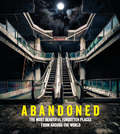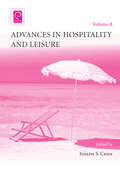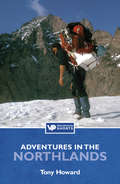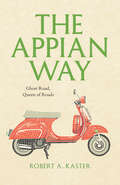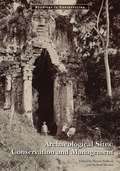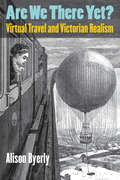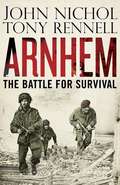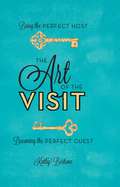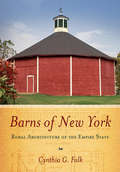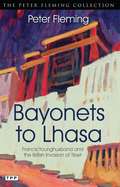- Table View
- List View
Abandoned: The most beautiful and forgotten places from around the world
by AbandonedThe places time forgotFrom the magical empty theatres of Detroit to the lost playgrounds of Chernobyl, there are places across the globe that were once a hub of activity, but are now abandoned and in decay. With nature creeping in and reclaiming these spots, we are left with eerie crumbling ruins and breathtaking views that offer us a window into the past and capture our imagination. Abandoned showcases the very best photographs from around the world documenting this phenomenon.More immersive than a museum and more human that a lecture, abandoned photography has given the world an exciting way to look at our history and the places we have long neglected.Compiled and curated by photographer and former urban explorer, Mathew Growcoot.
Advances in Hospitality and Leisure (Advances in Hospitality and Leisure #8)
by Jospeh S. ChenAssessment and outcomes evaluation have become increasingly important in librarianship. Although initially used in educational contexts to measure student learning, the strategy has migrated to other contexts such as hiring, employee development, overall organizational and institutional successes, measuring the outcomes of projects and operational changes, and self assessment at the personal level. This growing emphasis is partly due to increasingly stringent requirements that funds are used effectively to improve services and operations. The current economic climate and retrenchments in non-profit agencies, have raised the need for assessment and outcomes evaluation to a critical level. 'Contexts for Assessment and Outcome Evaluation in Librarianship' focuses not on the how of undertaking assessment and outcomes evaluation, but rather on their successes and failures in various contexts in which these tools have been and will be used.
Adventures in the Northlands: Vertebrate Mountain Shorts
by Tony HowardLightning hit the cliff high above us, sending a dumper-load of rocks thrumming like jagged cannonballs out of the clouds to explode around us. Bill took a direct hit on his helmet, which was smashed. He hung limply and silently on the rope. His face, which was streaming with blood from a gash in his head, was a ghastly shade of white. For a horrible moment, we thought he was dead, but he came round slowly. We suggested bivouacking until he recovered but Bill, who always thrived in adversity, was having none of it. Having bandaged his head and reversed his helmet so that the hole in it wasn't over the hole in his head, and at his insistence bunged a fag in his mouth to keep him happy, we continued into the storm up the last 300 metres of the snow covered cliff. We emerged triumphantly over the cornice into the blizzard and whiteout, another first ascent in the bag.' Adventures in the Northlands is a collection of short stories written by British adventurer and mountaineer Tony Howard. From a life spent in the mountains and wilderness, Tony recalls epic tales of climbing, kayaking and adventure from Greenland, the kon and, his home-from-home, Norway. Journey with Tony into some of the most incredible wild places on earth. Vertebrate Mountain Shorts are collections of mountaineering, climbing, adventure and wilderness writing, published as ebooks and intended to be read in one go. Written by some of the world's leading outdoor adventure authors, they include rare, previously out of print and exciting new works. Vertebrate Mountain Shorts will always be inspirational, direct and to the point.
Aeroplane (Large Print)
by RnibThis is an image of an aeroplane viewed from above. There is a locator dot shown, which will be at the top left of the page when the image is the right way up. The front (nose) of the aeroplane is at the left of the page, and the back (tail) on the right. The cockpit, where the pilot sits, is near the nose of the aeroplane. To the right of this is the long main cabin for the passengers. On each side of the passenger cabin there is a long wing. Each wing has an engine on the front, and flaps to control the aeroplane at the rear. The smaller wings making up the tail also have flaps at the rear.
Alps. The
by Ronald ClarkThe unrivalled scenery of the Alps attracts increasing numbers of visitors every year, while for those who seek the more active and dangerous pursuits of climbing and skiing, the region offers unique opportunities. Ronald Clark, a distinguished historian of mountaineering, who knows the Alps fromend to end, describes the history of the mountains and their most famous peaks. The heroic story of their exploration, first by scientists, then by such early mountaineers as Whymper, Coolidge, Miss Brevoort and their guides, is related with extensive quotations from letters, diaries and contemporary records. With the mountaineers came the pioneer photographers whose cumbersome but fragile equipment had to be manhandled up ice-slopes and across glaciers to enable them to take their photographs, a procedure which necessitated hours of intricate manoeuvring, in freezing weather, to obtain one successful shot. Other chapters discuss the development of the Alps as a mountain health centre, the coming of roads and railways and the growth of the winter sports industry and Mr Clark warns that the mountains, like a Highland deer forest, can carry only a certain number of living creatures without facing disaster.
Apollo 11 module on the moon (Large Print)
by RnibThis image is a side view of the Apollo 11 module, which carried and landed American astronauts on the moon in 1969. There is a locator dot shown, which will be at the top left of the page when the image is the right way up. The image has a dashed line image border. Also shown is the 'stars and stripes' American flag that was planted in the moon's surface during this mission. The Apollo 11 module is set against the darkness of space. At the top left of the page is a steerable S-band radio antenna and below this a radar antenna. Moving down and right is the crew compartment of the module with a fine texture. On the right hand side of this are: at the top a VHF antenna and down, one of the four reaction control thrusters, used for fine control of movement during landing. Down from the crew compartment is the rocket engine with a horizontal striped texture. To either side of this can be seen two of the module's four legs with their shock absorbing systems. On the leg to the left is a ladder shown from the side, and just above this an entry platform and hatch. On the right of the page is an American flag with some of its stars and stripes depicted. The surface of the moon is shown across the bottom of the page.
Apollo 11 module on the moon (UEB Contracted)
by RnibThis image is a side view of the Apollo 11 module, which carried and landed American astronauts on the moon in 1969. There is a locator dot shown, which will be at the top left of the page when the image is the right way up. The image has a dashed line image border. Also shown is the 'stars and stripes' American flag that was planted in the moon's surface during this mission. The Apollo 11 module is set against the darkness of space. At the top left of the page is a steerable S-band radio antenna and below this a radar antenna. Moving down and right is the crew compartment of the module with a fine texture. On the right hand side of this are: at the top a VHF antenna and down, one of the four reaction control thrusters, used for fine control of movement during landing. Down from the crew compartment is the rocket engine with a horizontal striped texture. To either side of this can be seen two of the module's four legs with their shock absorbing systems. On the leg to the left is a ladder shown from the side, and just above this an entry platform and hatch. On the right of the page is an American flag with some of its stars and stripes depicted. The surface of the moon is shown across the bottom of the page.
Apollo 11 module on the moon (UEB Uncontracted)
by RnibThis image is a side view of the Apollo 11 module, which carried and landed American astronauts on the moon in 1969. There is a locator dot shown, which will be at the top left of the page when the image is the right way up. The image has a dashed line image border. Also shown is the 'stars and stripes' American flag that was planted in the moon's surface during this mission. The Apollo 11 module is set against the darkness of space. At the top left of the page is a steerable S-band radio antenna and below this a radar antenna. Moving down and right is the crew compartment of the module with a fine texture. On the right hand side of this are: at the top a VHF antenna and down, one of the four reaction control thrusters, used for fine control of movement during landing. Down from the crew compartment is the rocket engine with a horizontal striped texture. To either side of this can be seen two of the module's four legs with their shock absorbing systems. On the leg to the left is a ladder shown from the side, and just above this an entry platform and hatch. On the right of the page is an American flag with some of its stars and stripes depicted. The surface of the moon is shown across the bottom of the page.
The Appian Way: Ghost Road, Queen of Roads (Culture Trails: Adventures in Travel)
by Robert A. KasterThe Roman poet Statius called the via Appia “the Queen of Roads,” and for nearly a thousand years that description held true, as countless travelers trod its path from the center of Rome to the heel of Italy. Today, the road is all but gone, destroyed by time, neglect, and the incursions of modernity; to travel the Appian Way today is to be a seeker, and to walk in the footsteps of ghosts. Our guide to those ghosts—and the layers of history they represent—is Robert A. Kaster. In The Appian Way, he brings a lifetime of studying Roman literature and history to his adventures along the ancient highway. A footsore Roman soldier pushing the imperial power south; craftsmen and farmers bringing their goods to the towns that lined the road; pious pilgrims headed to Jerusalem, using stage-by-stage directions we can still follow—all come to life once more as Kaster walks (and drives—and suffers car trouble) on what’s left of the Appian Way. Other voices help him tell the story: Cicero, Goethe, Hawthorne, Dickens, James, and even Monty Python offer commentary, insight, and curmudgeonly grumbles, their voices blending like the ages of the road to create a telescopic, perhaps kaleidoscopic, view of present and past. To stand on the remnants of the Via Appia today is to stand in the pathway of history. With The Appian Way, Kaster invites us to close our eyes and walk with him back in time, to the campaigns of Garibaldi, the revolt of Spartacus, and the glory days of Imperial Rome. No traveler will want to miss this fascinating journey.
The Appian Way: Ghost Road, Queen of Roads (Culture Trails: Adventures in Travel)
by Robert A. KasterThe Roman poet Statius called the via Appia “the Queen of Roads,” and for nearly a thousand years that description held true, as countless travelers trod its path from the center of Rome to the heel of Italy. Today, the road is all but gone, destroyed by time, neglect, and the incursions of modernity; to travel the Appian Way today is to be a seeker, and to walk in the footsteps of ghosts. Our guide to those ghosts—and the layers of history they represent—is Robert A. Kaster. In The Appian Way, he brings a lifetime of studying Roman literature and history to his adventures along the ancient highway. A footsore Roman soldier pushing the imperial power south; craftsmen and farmers bringing their goods to the towns that lined the road; pious pilgrims headed to Jerusalem, using stage-by-stage directions we can still follow—all come to life once more as Kaster walks (and drives—and suffers car trouble) on what’s left of the Appian Way. Other voices help him tell the story: Cicero, Goethe, Hawthorne, Dickens, James, and even Monty Python offer commentary, insight, and curmudgeonly grumbles, their voices blending like the ages of the road to create a telescopic, perhaps kaleidoscopic, view of present and past. To stand on the remnants of the Via Appia today is to stand in the pathway of history. With The Appian Way, Kaster invites us to close our eyes and walk with him back in time, to the campaigns of Garibaldi, the revolt of Spartacus, and the glory days of Imperial Rome. No traveler will want to miss this fascinating journey.
The Appian Way: Ghost Road, Queen of Roads (Culture Trails: Adventures in Travel)
by Robert A. KasterThe Roman poet Statius called the via Appia “the Queen of Roads,” and for nearly a thousand years that description held true, as countless travelers trod its path from the center of Rome to the heel of Italy. Today, the road is all but gone, destroyed by time, neglect, and the incursions of modernity; to travel the Appian Way today is to be a seeker, and to walk in the footsteps of ghosts. Our guide to those ghosts—and the layers of history they represent—is Robert A. Kaster. In The Appian Way, he brings a lifetime of studying Roman literature and history to his adventures along the ancient highway. A footsore Roman soldier pushing the imperial power south; craftsmen and farmers bringing their goods to the towns that lined the road; pious pilgrims headed to Jerusalem, using stage-by-stage directions we can still follow—all come to life once more as Kaster walks (and drives—and suffers car trouble) on what’s left of the Appian Way. Other voices help him tell the story: Cicero, Goethe, Hawthorne, Dickens, James, and even Monty Python offer commentary, insight, and curmudgeonly grumbles, their voices blending like the ages of the road to create a telescopic, perhaps kaleidoscopic, view of present and past. To stand on the remnants of the Via Appia today is to stand in the pathway of history. With The Appian Way, Kaster invites us to close our eyes and walk with him back in time, to the campaigns of Garibaldi, the revolt of Spartacus, and the glory days of Imperial Rome. No traveler will want to miss this fascinating journey.
The Appian Way: Ghost Road, Queen of Roads (Culture Trails: Adventures in Travel)
by Robert A. KasterThe Roman poet Statius called the via Appia “the Queen of Roads,” and for nearly a thousand years that description held true, as countless travelers trod its path from the center of Rome to the heel of Italy. Today, the road is all but gone, destroyed by time, neglect, and the incursions of modernity; to travel the Appian Way today is to be a seeker, and to walk in the footsteps of ghosts. Our guide to those ghosts—and the layers of history they represent—is Robert A. Kaster. In The Appian Way, he brings a lifetime of studying Roman literature and history to his adventures along the ancient highway. A footsore Roman soldier pushing the imperial power south; craftsmen and farmers bringing their goods to the towns that lined the road; pious pilgrims headed to Jerusalem, using stage-by-stage directions we can still follow—all come to life once more as Kaster walks (and drives—and suffers car trouble) on what’s left of the Appian Way. Other voices help him tell the story: Cicero, Goethe, Hawthorne, Dickens, James, and even Monty Python offer commentary, insight, and curmudgeonly grumbles, their voices blending like the ages of the road to create a telescopic, perhaps kaleidoscopic, view of present and past. To stand on the remnants of the Via Appia today is to stand in the pathway of history. With The Appian Way, Kaster invites us to close our eyes and walk with him back in time, to the campaigns of Garibaldi, the revolt of Spartacus, and the glory days of Imperial Rome. No traveler will want to miss this fascinating journey.
The Appian Way: Ghost Road, Queen of Roads (Culture Trails: Adventures in Travel)
by Robert A. KasterThe Roman poet Statius called the via Appia “the Queen of Roads,” and for nearly a thousand years that description held true, as countless travelers trod its path from the center of Rome to the heel of Italy. Today, the road is all but gone, destroyed by time, neglect, and the incursions of modernity; to travel the Appian Way today is to be a seeker, and to walk in the footsteps of ghosts. Our guide to those ghosts—and the layers of history they represent—is Robert A. Kaster. In The Appian Way, he brings a lifetime of studying Roman literature and history to his adventures along the ancient highway. A footsore Roman soldier pushing the imperial power south; craftsmen and farmers bringing their goods to the towns that lined the road; pious pilgrims headed to Jerusalem, using stage-by-stage directions we can still follow—all come to life once more as Kaster walks (and drives—and suffers car trouble) on what’s left of the Appian Way. Other voices help him tell the story: Cicero, Goethe, Hawthorne, Dickens, James, and even Monty Python offer commentary, insight, and curmudgeonly grumbles, their voices blending like the ages of the road to create a telescopic, perhaps kaleidoscopic, view of present and past. To stand on the remnants of the Via Appia today is to stand in the pathway of history. With The Appian Way, Kaster invites us to close our eyes and walk with him back in time, to the campaigns of Garibaldi, the revolt of Spartacus, and the glory days of Imperial Rome. No traveler will want to miss this fascinating journey.
The Appian Way: Ghost Road, Queen of Roads (Culture Trails: Adventures in Travel)
by Robert A. KasterThe Roman poet Statius called the via Appia “the Queen of Roads,” and for nearly a thousand years that description held true, as countless travelers trod its path from the center of Rome to the heel of Italy. Today, the road is all but gone, destroyed by time, neglect, and the incursions of modernity; to travel the Appian Way today is to be a seeker, and to walk in the footsteps of ghosts. Our guide to those ghosts—and the layers of history they represent—is Robert A. Kaster. In The Appian Way, he brings a lifetime of studying Roman literature and history to his adventures along the ancient highway. A footsore Roman soldier pushing the imperial power south; craftsmen and farmers bringing their goods to the towns that lined the road; pious pilgrims headed to Jerusalem, using stage-by-stage directions we can still follow—all come to life once more as Kaster walks (and drives—and suffers car trouble) on what’s left of the Appian Way. Other voices help him tell the story: Cicero, Goethe, Hawthorne, Dickens, James, and even Monty Python offer commentary, insight, and curmudgeonly grumbles, their voices blending like the ages of the road to create a telescopic, perhaps kaleidoscopic, view of present and past. To stand on the remnants of the Via Appia today is to stand in the pathway of history. With The Appian Way, Kaster invites us to close our eyes and walk with him back in time, to the campaigns of Garibaldi, the revolt of Spartacus, and the glory days of Imperial Rome. No traveler will want to miss this fascinating journey.
The Appian Way: Ghost Road, Queen of Roads (Culture Trails: Adventures in Travel)
by Robert A. KasterThe Roman poet Statius called the via Appia “the Queen of Roads,” and for nearly a thousand years that description held true, as countless travelers trod its path from the center of Rome to the heel of Italy. Today, the road is all but gone, destroyed by time, neglect, and the incursions of modernity; to travel the Appian Way today is to be a seeker, and to walk in the footsteps of ghosts. Our guide to those ghosts—and the layers of history they represent—is Robert A. Kaster. In The Appian Way, he brings a lifetime of studying Roman literature and history to his adventures along the ancient highway. A footsore Roman soldier pushing the imperial power south; craftsmen and farmers bringing their goods to the towns that lined the road; pious pilgrims headed to Jerusalem, using stage-by-stage directions we can still follow—all come to life once more as Kaster walks (and drives—and suffers car trouble) on what’s left of the Appian Way. Other voices help him tell the story: Cicero, Goethe, Hawthorne, Dickens, James, and even Monty Python offer commentary, insight, and curmudgeonly grumbles, their voices blending like the ages of the road to create a telescopic, perhaps kaleidoscopic, view of present and past. To stand on the remnants of the Via Appia today is to stand in the pathway of history. With The Appian Way, Kaster invites us to close our eyes and walk with him back in time, to the campaigns of Garibaldi, the revolt of Spartacus, and the glory days of Imperial Rome. No traveler will want to miss this fascinating journey.
Archaeological Sites: Conservation And Management (PDF)
by Sharon Sullivan Richard MackayThe fifth volume in the Getty¿s Readings in Conservation series features more than seventy texts that have made important contributions to the understanding of the conservation and management of archaeological sites, addressing key issues from both a historical and a contemporary perspective. The readings cover a broad spectrum of site types, geographic locations, cultural contexts, and methodological approaches and techniques. They range chronologically from early eighteenth-century memoirs and late nineteenth- and early twentieth-century texts by such pioneers as Heinrich Schliemann and Sir Arthur Evans to a thorough representation of recent scholarship. The volume is divided into five parts focusing on historical methods, concepts, and issues; conserving the archaeological resource; the physical conservation of archaeological sites; the cultural values of archaeological sites; and site management.
Are We There Yet?: Virtual Travel and Victorian Realism
by Alison ByerlyAre We There Yet? Virtual Travel and Victorian Realism connects the Victorian fascination with "virtual travel" with the rise of realism in nineteenth-century fiction and twenty-first-century experiments in virtual reality. Even as the expansion of river and railway networks in the nineteenth century made travel easier than ever before, staying at home and fantasizing about travel turned into a favorite pastime. New ways of representing place—360-degree panoramas, foldout river maps, exhaustive railway guides—offered themselves as substitutes for actual travel. Thinking of these representations as a form of "virtual travel" reveals a surprising continuity between the Victorian fascination with imaginative dislocation and twenty-first -century efforts to use digital technology to expand the physical boundaries of the self.
Arnhem: The Battle for Survival
by John Nichol Tony RennellIn September 1944, a mighty shock force of battle hardened Allied troops dropped from the skies into enemy-occupied Holland in what was hoped would be the decisive final battle of World War II.Landing miles behind the German lines, their daring mission was to secure bridges across the Rhine so that ground forces could make a rapid dash into Nazi Germany. If all went well, the war could be over by Christmas.But what many trusted would be a simple operation turned into a brutal losing battle. Of 12,000 British airborne soldiers, 1,500 died and 6,000 were taken prisoner. The vital bridge at Arnhem they had come to capture stayed resolutely in German hands.But though this was a bitter military defeat for the Allies, beneath the humiliation was another story - of heroism and self-sacrifice, gallantry and survival, guts and determination unbroken in the face of impossible odds.In the two-thirds of a century that have passed since then, historians have endlessly analysed what went wrong and squabbled over who was to blame. Lost in the process was that other Arnhem story - the triumph of the human spirit, as seen through the dramatic first-hand accounts of those who were there, in the cauldron, fighting for their lives, fighting for their comrades, fighting for their honour, a battle they won hands down.
Around India in 80 Trains: One of the Independent's Top 10 Books about India
by Monisha Rajesh'Crackles and sparks with life like an exploding box of Diwali fireworks' -William Dalrymple'One can only envy Monisha Rajesh as she embarks on this epic journey' -Tim ParksWhen she was a child, Monisha Rajesh's family uprooted to Madras in the hope of making India their home, but soon returned to England with a bitter taste in their mouths. Two decades on, Monisha turns to a map of the Indian Railways and takes a page out of Jules Verne's classic tale, embarking on an adventure around India in 80 trains, covering 40,000km - the circumference of the Earth.Her journey takes her on toy trains, luxury trains, Mumbai's infamous commuter trains and even a hospital on wheels. Along the way she meets a kaleidoscope of characters and discovers why the railways are considered the lifeline that keeps the country's heart beating. Most of all, she hopes that these 80 train journeys will lift the veil on a country that has become a stranger to her.
The Art of the Visit: Being the Perfect Host/Becoming the Perfect Guest
by Kathy BertoneThe Art of the Visit is an invaluable resource for the socially minded. During tough economic periods people tend to visit with family and friends for a mini-vacation instead of taking more expensive trips. This practical and humorous guide establishes the ground rules for successfully spending time with those people who are most dear to us. Full of anecdotes from the author&’s experiences, The Art of the Visit illustrates the dos and don&’ts of extended visiting from start to finish so that the reader can become the perfect host and/or the perfect guest.
The Art of the Visit: Being the Perfect Host/Becoming the Perfect Guest
by Kathy BertoneThe Art of the Visit is an invaluable resource for the socially minded. During tough economic periods people tend to visit with family and friends for a mini-vacation instead of taking more expensive trips. This practical and humorous guide establishes the ground rules for successfully spending time with those people who are most dear to us. Full of anecdotes from the author's experiences, The Art of the Visit illustrates the dos and don'ts of extended visiting from start to finish so that the reader can become the perfect host and/or the perfect guest.
The Aye-Aye and I: A Rescue Journey To Save One Of The World's Most Intriguing Creatures From Extinction
by Gerald Durrell'In the gloom it came along the branches towards me, its round, hypnotic eyes blazing, its spoon-like ears turning to and fro independently like radar dishes . . . it was Lewis Carroll's Jabberwocky come to life . . . one of the most incredible creatures I had ever been privileged to meet.'The fourth largest island in the world, Madagascar is home to woodlice the size of golf balls, moths the size of Regency fans and the Aye-Aye, a type of lemur held by local superstion to be an omen of death. But when Gerald Durrell visited the island, the destruction of the forests meant that the Aye-Aye and many other creatures were in danger of extinction.Told with his unique sense of humour and inimitable charm, Gerald Durrell's The Aye Aye and I is the final adventure from one Britain's best loved conservationists.
Barns of New York: Rural Architecture of the Empire State
by Cynthia G. FalkBarns of New York explores and celebrates the agricultural and architectural diversity of the Empire State—from Long Island to Lake Erie, the Southern Tier to the North Country—providing a unique compendium of the vernacular architecture of rural New York. Through descriptions of the appearance and working of representative historic farm buildings, Barns of New York also serves as an authoritative reference for historic preservation efforts across the state.Cynthia G. Falk connects agricultural buildings—both extant examples and those long gone—with the products and processes they made and make possible. Great attention is paid not only to main barns but also to agricultural outbuildings such as chicken coops, smokehouses, and windmills. Falk further emphasizes the types of buildings used to support the cultivation of products specifically associated with the Empire State, including hops, apples, cheese, and maple syrup.Enhanced by more than two hundred contemporary and historic photographs and other images, this book provides historical, cultural, and economic context for understanding the rural landscape. In an appendix are lists of historic farm buildings open to the public at living history museums and historic sites. Through a greater awareness of the buildings found on farms throughout New York, readers will come away with an increased appreciation for the state’s rich agricultural and architectural legacy.
Bayonets to Lhasa: The British Invasion of Tibet
by Peter FlemingThe British invasion of Tibet in 1904 is one of the strangest events in British imperial history. Conceived by Lord Curzon as a strategic move in the Great Game - that colossal struggle between Imperial Britain and Tsarist Russia for influence in Central Asia - the incursion was in fact ill-conceived and inspired by only the weakest of motivations. Led by the soldier, explorer and mystic, Francis Younghusband, the mission - doomed from the very beginning - became caught in political cross-fire and the distant and destructive machinations of China and Britain and ended in ignominy and disappointment for this idealistic adventurer. Peter Fleming's gripping portrayal of this curious episode and its charismatic protagonists brilliantly illuminates what is now seen as a key moment in the Great Game, the repercussions of which continue to be felt throughout the region.
Bear Grylls: Facing Up - Facing the Frozen Ocean
by Bear GryllsBear Grylls is one of the world's most famous survivors. Bear Grylls: Two All-Action Adventures combines two of his greatest adventures told in Facing Up and Facing the Frozen Ocean.At the age of twenty-three, Bear Grylls became one of the youngest Britons to reach the summit of Mount Everest. At extreme altitude youth holds no advantage over experience, nevertheless, only two years after breaking his back in a freefall parachuting accident, he overcame severe weather conditions, fatigue and dehydration to stand on top of the world's highest mountain. Facing Up is the story of his adventure, his courage and humour, his friendship and faith. Facing the Frozen Ocean tells of a carefully calculated attempt to complete the first unassisted crossing of the frozen north Atlantic in an open rigid inflatable boat. But this expedition became a terrifying battle against extreme elements and icebergs as large as cathedrals. Starting from the remote north Canadian coastline, Bear Grylls and his crew crossed the infamous Labrador Sea, pushed on through ice-strewn waters to Greenland and then found themselves isolated in a perfect storm 400 miles from Iceland. This is a compelling, vivid and inspirational tale.
